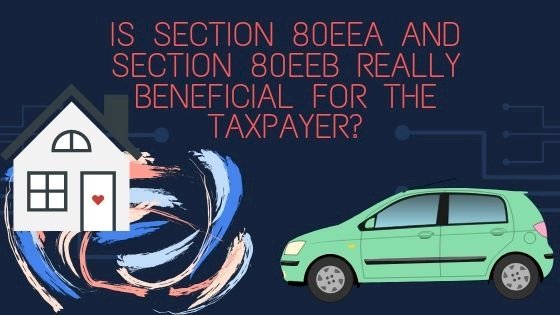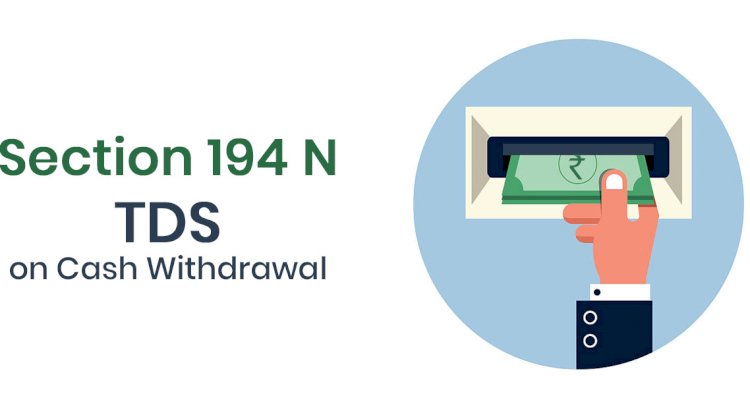Impact of SECTION-80EEA, 80EEB , 194N, AND 194M Under Tax audit AY-20-21

Section 80EEA
Eligibility criteria
The deduction under this section is available only to individuals. This deduction is not available to any other taxpayer.
Thus, if you are a HUF, AOP, Partnership firm, a company, or any other kind of taxpayer, you cannot claim any benefit under this section.
Amount of deduction
A deduction for interest payments up to Rs 150,000 is available under Section 80EEA.
This deduction is over and above the deduction of Rs 2 lakh for interest payments available under Section 24 of the Income Tax Act.
Therefore, taxpayers can claim a total deduction of Rs 3.5L for interest on home loan, if they meet the conditions of section 80EEA.
Other conditions
Similar to Section 80EE, in order to claim deduction under Section 80EEA,
you should not own any other house property on the date of the sanction of a loan.
Conditions for claiming the deduction
- Housing loan must be taken from a financial institution or a housing finance company for buying a residential house property.
- Stamp duty value of the house property should be Rs 45 lakhs or less.
- The individual taxpayer should not be eligible to claim deduction under the existing Section 80EE.
- The taxpayer should be a first-time home buyer. The taxpayer should not own any residential house property as on the date of sanction of the loan.
Conditions with respect to the carpet area of the house property.
These conditions have been specified in the memorandum to the finance bill, but not mentioned in section 80EEA:
- Carpet area of the house property should not exceed 60 square meter ( 645 sq ft) in metropolitan cities of Bengaluru, Chennai, Delhi National Capital Region (limited to Delhi, Noida, Greater Noida, Ghaziabad, Gurgaon, Faridabad), Hyderabad, Kolkata and Mumbai (whole of Mumbai Metropolitan Region)
- Carpet area should not exceed 90 square meter (968 sq ft) in any other cities or towns.
- Further, this definition will be effective for affordable real estate projects approved on or after 1 September 2019
Section 80EEA has been introduced to further extend the benefits allowed under Section 80EE for low-cost housing.
Earlier, Section 80EE had been amended from time to time to allow a deduction for interest paid on housing loan for the FY 2013-14, FY 2014-15, and FY 2016-17.
The section does not specify if you need to be a Resident to be able to claim this benefit. Therefore, it can be concluded that both Resident and Non-Resident Indians can claim this deduction.
The section also does not specify if the residential house should be self-occupied to claim the deduction.
So, borrowers living in rented houses can also claim this deduction. Moreover, the deduction can only be claimed by individuals for the house purchases jointly or singly.
If a person jointly owns the house with a spouse and they both are paying the installments of the loan, then both of them can claim this deduction. However, they must meet all the conditions laid down.
Section 80EEA and Section 24
Under Section 24,
Home owners can claim a deduction for interest payments up to Rs 2 lakh on their home loan, if the owner or his family resides in the house property.
The deduction of up to Rs 2 Lakh applies even when the house is vacant. If you have rented out the property, the entire home loan interest is allowed as a deduction.
If you are able to satisfy the conditions of both Section 24 and Section 80EEA of the Income Tax Act, you can claim the benefits under both the sections.
First, exhaust your deductible limit under Section 24, which is Rs 2 lakh. Then, go on to claim the additional benefits under Section 80EEA. Therefore, this deduction is in addition to the Rs 2 lakh limit allowed under Section 24.
Section 80EEB
Newly introduced section 80EEB provides deduction in respect of interest paid on loan taken from the financial institution for purchasing of an electric vehicle.
Features of newly inserted section 80EEB –
The features of section 80EEB of the Income Tax Act is listed hereunder –
- Deduction under section 80EEB is available only to an individual.
- Accordingly, the deduction is not available to any other assessee like AOP, HUF, company, firm etc.
- In the absence of any specification, deduction under section 80EEB is available to both resident as well as a non-resident individual.
- The deduction is available only if the loan is taken from the financial institution for the purpose of acquiring/ buying an electric vehicle.
- The loan should have been approved during the period 1st April 2019 to 31stMarch 2023.
- The maximum amount of deduction available under section 80EEB is INR 1.50 Lakhs.
- The deduction of interest amount shall be available under section 80EEB from 1stApril 2020 till the repayment of a loan.
- Once the deduction with respect to interest has been claimed under section 80EEB, no further deduction can be claimed for such interest payment under any other provisions of the Act for the same or any other assessment year.
- The most important definition of the term ‘electric vehicle’ is contained under section 80EEB (5) (a). ‘Electric Vehicle’ here means a vehicle which is powered exclusively by an electric motor whose transaction energy is supplied exclusively by transaction battery installed in the vehicle and has an electric regenerative braking system.
- ‘financial institution’ has been defined under section 80EEB (5) (b) which means
- A banking company to which the Banking Regulation Act applies; or
- Any bank or banking institution referred to in section 51 of the Banking Regulation Act.
- The term includes any deposits taking the non-banking financial companyor a systematically important non-deposit taking the non-banking financial company as defined under Explanation 4 (e) and (g) to section 43B.

Section 194N
Section 194N is applicable in case of cash withdrawals of more than Rs 1 crore during a financial year. This section will apply to all the sum of money or an aggregate of sums withdrawn from a particular payer in a financial year.
The section will apply to withdrawals made by any taxpayer including:
- An Individual
- A Hindu Undivided Family (HUF)
- A Company
- A partnership firm or an LLP
- A local authority
- An Association of Person (AOPs) or Body of Individuals (BOIs)
The following payers are covered under this section:
- Any bank (private or public sector)
- A co-operative bank
- A post office
The tax will be deducted by the payer while making payment to any individual in cash from a taxpayer’s bank account on the amount in excess of Rs 1 crore.
The limit of Rs 1 crore in a financial year is with respect to per bank or post office account and not a taxpayer’s individual account.
For example, a person having three bank accounts with three different banks, he can withdraw cash of Rs 1 crore * 3 = Rs 3 crores without any TDS.
The cash withdrawal made by any taxpayer from the bank accounts maintained by such recipient will only attract TDS under Section 194N.
For instance, if a bank makes a cash payment of more than Rs 1 crore in an FY to its account holder (i.e any taxpayer) from the account maintained by such taxpayer, then the bank will have to deduct TDS.
In the case of a payment made by a taxpayer through a bearer cheque issued to third party, in excess of Rs 1 crore in a financial year, the recipient of the cash is not the account holder, but a third party. In such a case, the payment is not made by the bank to the account holder.
In the above situation, there is an ambiguity that whether such bearer cheque given to any person (like vendor) to collect payment from the bank will be covered under section 194N? Whether the bank is liable to deduct tax on the funds of the account holder in respect of the bearer cheque issued to third party.
Separately, in case of business payments, payment made through a bearer cheque would not be allowed as an expenditure under section 40(A)(3) of the income tax act.
Any payment made exceeding Rs 10,000 per day (in a single transaction or in aggregate) is not allowed as business expenditure.
The limit of Rs 1 crore will be applicable to the cash payments/withdrawals made during the FY 2019-20. The provisions of Section 194N will be applied to the payments made on or after 1 September 2019.
Section 194N introduced
The government has introduced Section 194N in the Union Budget 2019 proposed on 5 July 2019. In order to discourage cash transactions in the country and promote the digital economy,
‘Section 194N – TDS on cash withdrawals over and above Rs 1 crore’ has been introduced through the Finance Bill, 2019.
Who will deduct TDS under Section 194N
The person (payer) making the cash payment will have to deduct TDS under Section 194N. Here is the list of such persons:
- Any bank (private or public sector)
- A co-operative bank
- A post office
There are certain categories of person (payee) to whom the provision of this section will not apply. They are listed below:
Any government body
- Any bank including co-operative banks
- Any business correspondent of a banking company (including co-operative banks)
- Any white label ATM operator of any bank (including co-operative banks)
- Any other person notified by the government
Point of TDS under Section 194N
TDS will be deducted by the payer while making the cash payment over and above Rs 1 crore in a financial year to the payee.
If the payee withdraws a sum of money on regular intervals, the payer will have to deduct TDS from the amount, once the total sum withdrawn exceeds Rs 1 crore in a financial year.
Further, the TDS will be done on the amount exceeding Rs 1 crore.
For example, if a person withdraws Rs 99 lakh in the aggregate in the financial year and in the next withdrawal, an amount of Rs 1,50,000 is withdrawn, the TDS liability is only on the excess amount of Rs 50,000.
Rate of TDS under Section 194N
The payer will have to deduct TDS at the rate of 2% on the cash payments/withdrawals of more than Rs 1 crore in a financial year under Section 194N. Thus, in the above example, TDS would be on Rs 50,000 at 2% i.e. Rs 1,000.

Section 194M
- An individual and/or Hindu undivided family (HUF) has to deduct tax at source under Section 194M. Such individuals and HUF must not be required to get their books of accounts audited.
Books of Accounts are required to be audited if total turnover or receipts of a business exceed Rs 1 crore or where receipts of a profession exceed Rs 50 lakh.
- It applies when the total amount paid to a resident individual, for carrying out any contractual work or providing any professional service, in a financial year exceeds Rs 50,00,000.
- If they are required to get Books of Accounts audited, TDS deduction is applicable as per Section 194C and 194J. The individual and/or HUF who have to deduct TDS under Section 194C (TDS on payment to a contractor) and 194J (TDS on payment on professional fees) do not have to deduct tax at source under Section 194M.
- The individual or HUFs who has to deduct tax can pay the tax to the government by quoting his or her PAN only. Not required to get a tax deduction account number (TAN) for TDS deduction.
- Payments to non-residents are not covered under this section.
Reason for the introduction of Section 194M
- The finance bill, 2019 has introduced Section 194M, regarding tax deduction at source from any money paid by an individual or HUF to a resident contractor when the services are provided for personal use. Therefore, this section applies to personal as well as business related payments.
- Before the introduction of this section, there was no liability on an individual or HUF to deduct tax at source in the situation mentioned above.
- Also, the individuals or HUFs carrying business or profession (not subjected to any audit) were also not deducting any tax at source, even when the payment was made for the purpose of business or profession.
- A major amount of payment made for contractual works and professional fees was escaping the levy of TDS because of this exemption, creating a scope for tax evasion.
Meaning of ‘work’, ‘contract’, and ‘professional services’ in Section 194M
Work: The expression, “work” in this section would include:
- Advertising
- Broadcasting and telecasting including production of programs for such broadcasting or telecasting.
- Carriage of goods and passengers by any mode of transportation, other than railways.
- Catering.
- Manufacturing or supplying a product according to the requirement or specification of a customer by using material purchased from such customer. But does not include manufacturing or supplying a product according to the requirements or specifications of a customer by using material purchased from a person, other than such a customer.
Professional services: The phrase, professional services in this section would include:
- Professional fees
- Fees for technical services
- Remuneration paid to directors excluding salary (For example, sitting fees to attend board meetings)
- Royalty
- Payments in the nature of non-compete fees (i.e., fees paid to not carry on any business or profession for a specified time and within certain geographical boundaries) or fees paid to not share any technical knowledge or know-how.
Contract: This expression includes sub-contract.
Deduct TDS u/s 194M
- The person being an individual or HUF, who has to make payment to a resident for a contract work completed or any professional service provided, will have to deduct tax at source under 194M.
- As per the Union Budget 2019, any individual/HUF paying any sum to a resident, for carrying out any work (including the supply of labour) under any contract or by way of fees for professional services rendered during the financial year, exceeding Rs 50,00,000 in a year will have to deduct TDS at 5%.
- This section will be effective from 1 September 2019 onwards. TDS amount will be deducted on any payment made after this date even if the contract existed before, provided the payment exceeds Rs 50,00,000.
When can one deduct tax at source under 194M?
TDS amount will be deducted on the earlier of the following dates:
- At the time of credit of the amount.
- At the time of payment by cash or by the issue of a cheque or draft.
Rate of TDS under Section 194M
TDS at 5% will be deducted under 194M if the total amount paid to a resident exceeds
Rs 50,00,000 in a particular financial year.
In case the PAN of the deductee is not available, then TDS will be deducted at 20%.
Time limit on depositing TDS
- When any payment is made by or on behalf of the government – The TDS amount will have to be paid to the department on the day of the payment.
- Where any payment is made by any other person apart from the government:
The TDS will have to be paid:
- If the amount is paid in March – on or before April 30 of the next financial year. For example, if the amount has been paid in March 2020, then the TDS will be deposited to the department by 30 April 2020.
- In any other month – within seven days from the end of the month in which the tax deduction is made. For example, if the amount has been paid in the month of September 2019, then the TDS will be deposited to the department by 7 October 2019.
What's Your Reaction?





















